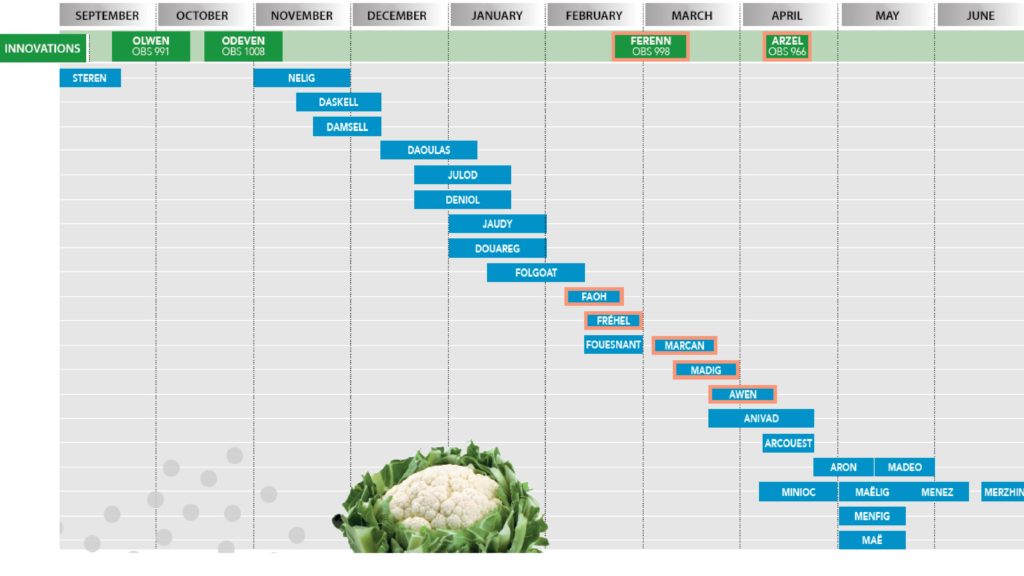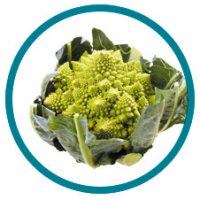Le cauliflower
The OBS offers you a range of cauliflower varieties to cover a wide production schedule:


4 novelties to test in cauliflower…. and a romanesco!
For the summer/autumn’s range, two new varieties are being evaluated
in network B2 and will be seen in 2nd year:
- Olwen (OBS991) : is the earliest of the two with a cycle of 85 to 90 days. This variety can be planted as early as March for summer harvests. It is distinguished by the quality of its cover, the whiteness of its apple and its low susceptibility to rossing.
- Odeven (OBS 1008) : on an end of decay niche, anique. It is a well covered variety with a small size (a slight butting is enough). Until now, it has been distinguished by the quality of its crown.
On a slot at the end of February, just before Clemen, we offer you:
- Ferenn (OBS 998) : has a rustic foliage due to its high resistance to Mycosphaerella. Its apple is heavy and white.
- Arzel (OBS 966) : mid-April variety on an Arcouest niche. It is newly retained by the B2 network with a 3-year average of 6.9. This variety has long, erect leaves that protect the apple.
The OBS offers you a slot at the end of November, beginning of December:
- DASKELL (OBS 923) : close to Damsell (1 front cut). Gain in homogeneity and coverage.
- DREMWELL (OBS 935) : starts 10 days after Damsell. Very good coverage. Variety intended to make a junction between the series of Daskell and Daoulas. The calibre is not always easy to evaluate.
- DAOULAS (OBS 959) : On December this variety has been tested on a large scale for 2 years. The producers of the networks find it interesting for its winter type foliage, its flexibility, the quality of the crown and the apple.
- STEREN : Breeding short-cycle cultivars had been requested by the profession twelve years ago. This cauliflower located on a Spacestar, Cortès’s slot, has the advantage of being able to be planted as early as February for a summer harvest. Its main assets are its very white head, which is not sensitive to reddening, and its cover with a pretty tendrill.
The OBS offers you on winter:
- FOUESNANT (OBS 964) : is on a slot at the end of February. Its major strengths are to present a very white and dense apple with bluish foliage.
- JULOD (OBS 938) : on an early Deniol niche. This variety has good foliage behaviour. So far, we have never encountered a chitoun problem on this variety.
- JABADAO (OBS 933) : on a Deniol niche. This variety also has good foliage behaviour. On the other hand, the apple being higher in the foliage, it is to be used in coastal plots.
- JAUDY (OBS 960) : is of the same precocity as Douareg. Its main advantage is to present a compliant and dense apple.
- FOLGOAT (OBS 939) : on a Douareg niche, good foliage quality. No chitoun problem.
- FLAMMEN (OBS 948) : is of the same precocity as Juluan. Its main characteristic is the quality of its crown. Its apple density is not very high which is a real advantage in cold winter.
- MADIG (OBS 945) : on a half niche at the end of March, this variety arrives in cup just after Marcan. Highly resistant to mycosphaërella.
The OBS proposes you on spring:
- ARON (OBS 964) : harvested between Arcouest and Maëlig. It is a vigorous variety, homogeneous with heavy apples and well covered. It is not susceptible to mycosphaetarella but is not highly resistant.
- MAËLIG (obs 928) : on a Maë niche, this variety has been described by producers as being more homogeneous, better covered and less sensitive to loosening.
- MARZIN (obs 927) : to strengthen this niche. This variety arrives in cup on average one week after Maë. Its growth rate is not too fast to space the cuts.
- MENEZ (obs 916) : 15 days after Maëlig. This variety has the advantage of being able to produce high-quality late cauliflower with mini-clods.
The romanesco

Eckmühl, variety of romanesco
- ECKMÜHL : This is the first romanesco variety in our range.On the October’s slot, it is distinguished for its apple quality and the regularity of its beautiful pyramid.
- ROSKOF (OBS 1002) : This romanesco has a very good attitude towards Mycosphaerella and Phytophtora brassicae. Its cycle is 140 to 150 days (10 to 20 days after Lazio). Its planting is not recommended before week 30.


